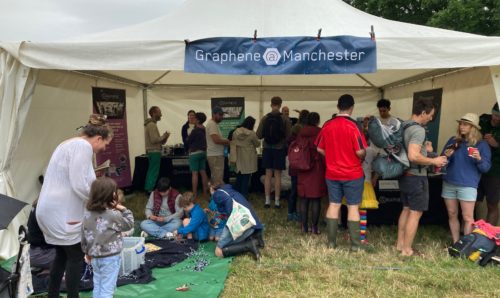Colloids: masters of masterbatch
Applications Collaborations National Graphene Institute 23rd March 2022
We caught up with one of the longest-term partners of Graphene@Manchester – Colloids – to talk about masterbatch: what it is, how it works and why graphene and related 2D materials are the key to a new era of multi-functional plastics.
One of the key areas of research and development for graphene, one that shows genuine market-scale promise in the near-term, is that of thermoplastic polymers: plastics formulated with graphene dispersions of varying strength to deliver significant and multi-functional gains over traditional solutions.
Those gains derive from graphene’s unique set of properties, namely extreme mechanical strength, and very high electrical and thermal conductivity.
Colloids, an industrial partner of Graphene@Manchester, is a company that specialises in this kind of polymer formulation. Indeed, the word ‘colloid’ is defined as ‘a homogenous dispersion of one substance through another’. And it’s here that one of the central challenges of graphene engineering – agglomeration – aligns with decades of experience in delivering consistency in nanocomposites.

Derek Hepburn is Colloids Technical Director and explains the fundamental issues. “Our focus is on dispersion, especially with nanoparticles,” he says. “What happens as you go down in size to nanometre scale is the tendency that particles will try to agglomerate, to minimise surface energy – it’s physics. So we’ve developed our technology to reduce those agglomerates.”
How you achieve that is a question of energy, adds Derek (pictured). “We provide extremely high dispersion and it’s a question of how much energy you put into the polymer when you’re processing it. You’ve got to balance that because if you put in too much energy you can start to degrade the polymer or you can start to damage the graphene flakes. It’s a very narrow operating window.”
The company’s work with graphene is comparatively new – around seven years since inception – but more than 30 years have passed since Colloids started using nanomaterials such as carbon black. That accrued knowledge has given the firm a head-start in understanding how to optimise processes for graphene and an ideal position to exploit the growing market for multi-functional materials. But before we look at future prospects, first, a little background.
Origins of Colloids
Back in 1967, Colloids was established by an American Cambridge University graduate, Earnest Branch. His father, Dr Arthur Branch ran Carbon Dispersion Inc in the US. They spotted an opportunity to grow the export market for thermoplastic masterbatch. The company grew quickly, Derek says, “given a lift through a deal with BP Chemicals [now Ineos] in Grangemouth and in Barry, who were producing compounds for pressure pipe and needed well-dispersed masterbatch.” Through the 1970s, the firm rapidly became one of the world’s leaders in the sector.
So what exactly is masterbatch? You may think of it like the plastic equivalent of a fruit cordial: a concentrated mixture to be diluted by the user to the required level in a finished product. The difference in thermoplastic masterbatch is that the concentration pertains to colour and function rather than taste, and the product appears in pellet form (see main pic, above). Those pellets are then melted into a host polymer and formed into end-user products as needed: for example, by extrusion, injection moulding or compounding.
Nanomaterials take effect by delivering function beyond simple shape and colour, moving into the realm of multi-purpose composites. And this is where The University of Manchester comes into the picture. Colloids did some initial work with the University back in 2015, enabling scale-up of graphene composites with their pilot line, which was bigger than anything available on campus. But the partnership accelerated when Derek joined the firm and identified potential for collaboration with the National Graphene Institute (NGI) on a more ambitious programme of work.
He hired Marios Michailidis, straight from his PhD in nanomaterials at The University of Liverpool, to be the firm’s R&D Technologist to lead the new product developments, and embedded him one day a week in the NGI to pursue a ‘pathfinder’ project on multifunctional polymer systems. Marios, originally from Greece with a background in chemistry and polymer science and a professed fascination with graphene, takes up the story.
“Every Monday, I joined the nanomaterials research group in the NGI run by Prof Bob Young, Prof Ian Kinloch and Dr Mark Bissett, one of the biggest in the NGI with about 40 members in the group,” says Marios (pictured).
“We had brainstorming meetings every week to get some ideas and inspiration for potential projects. We submitted a proposal about potential projects that Colloids could sponsor to see the benefits in thermoplastics by using graphene and other 2D materials.
“So we came up with the idea of using hybrid systems, combining graphene with other nanomaterials to develop multifunctional applications that take advantage of the properties of those different materials.”
Multiple ingredients
The complexity here is the sheer number of variables at your disposal once you consider using nanomaterials such as carbon black and carbon nanotubes alongside graphene and other 2D materials, the loadings of each, how they scale… what, in the end, you’re trying to achieve and what recipe you use.
The aforementioned Dr Mark Bissett is a Senior Lecturer in Nanomaterials and explains some of the challenges.
“There’s quite a lot of parameter space, here, and a lot of variables to play around with. Different ratios, different chemical functionalisations of those materials and different processing conditions. And then scaling all that up to the masterbatch volumes that Colloids use,” says Mark (pictured).
“One of the things that Manchester brings is a lot of experience with advanced materials in different situations. But it’s still very complex to deliver multi-functional improvements across the board.”
One of the central problems – for graphene at least – is that different loadings in the polymer lend themselves to different functionalities. For mechanical strength, you’re better off with a low loading of graphene; for electrical and thermal conductivity, you need higher loadings. If you want all three properties, there will need to be a trade-off somewhere.
“So then it becomes a question of what’s most important to you,” adds Mark. “Can I accept a small reduction in mechanical strength if I get a big improvement in thermal?”
“The question is, by adding multiple materials, looking at composites of different materials and different ratios, can we have our cake and eat it, too? Can we get improvements across the board, or at least minimise reductions across the board, so we can get stronger, more electrically, more thermally conductive material, without having too much of a trade-off in one or the other?”
Business-relevant research
In such a complicated field of play, Mark says Colloids has played a crucial role in narrowing the focus of the work. “We took Colloids’ advice to make it most business-relevant to them in terms of market share and what their target market was based on price-points. They wanted to focus on their niche products.”
To that end, Colloids has developed a twin-track approach, sponsoring a four-year PhD studentship at the NGI (currently entering its second year), as well as bringing a first graphene-enhanced masterbatch, GRAPHANCED®, to market in late 2021. The aim over time is to bring the fundamental knowledge gained in the use of multiple 2D materials into an increasingly advanced range of multi-functional grades of masterbatch.
Marios adds: “GRAPHANCED® is the brand name of a product range of graphene masterbatches but it’s not really an off-the-shelf product. Our ultimate purpose is make bespoke formulations for each customer. So the data that we have produced from extensive internal trials is not to deliver a single product code or a product on a shelf, but to show customers what can be achieved by using graphene in these polymers.
“When the customer has an interest, then we need to sit down with them and talk about bespoke formulations because, depending on their requirements and performance targets, we need to find the right formulation, either by using one type of graphene or a mixture of them, or the specific size of platelets. You have to strike a balance between over-designing or under-designing a product.
“The work in the PhD project is more ambitious – looking at hybrid systems and combining graphene with other nanomaterials to be introduced in thermoplastic-based polymers for future applications. This is the future for Colloids: to set the bar really high for innovative products.”
Bespoke masterbatch
GRAPHANCED® formally launched at the Compounding World Expo in Essen in September 2021 and has attracted plenty of interest from customers. The GRAPHANCED® product range includes all thermoplastic base polymers, from polyolefins through to ultra-performance polymers. Depending upon the customer’s final application, Colloids can develop a solution for its customers based on graphene and other 2D materials (if necessary) to meet a range of performance improvement targets. Careful formulation selection is essential to obtain advanced 2D composites with optimal properties.
In conclusion, Derek Hepburn reflects on the importance of the relationships with the NGI and GEIC. “We are located close to The University of Manchester and have enjoyed links with the University for a considerable time. Many of our employees, including myself, are alumni. The NGI and GEIC are globally recognised centres of excellence for cutting-edge graphene research. This led us to understand and grasp the potential of graphene from an early stage.
“We are pleased to have strengthened our links with UoM, with the support of further graphene research at the NGI and GEIC, and have access to their extensive graphene research facilities. We have built good relationships through the graphene supply chain and have been able to offer a commercial testbed for graphene manufacturers.
“Finally, we have been able to exploit our leading position of providing masterbatch to major polymer manufacturers, where there is a thirst to consistently innovate and improve their resins. This means that we have been able to introduce new products and supply chain partners to provide exciting new developments to them including our work on graphene.”
2DmaterialsAdvanced materialscolloidsengineeringGEICgrapheneGraphene Engineering Innovation CentremasterbatchnanomaterialsNational Graphene Institutengipolymers




